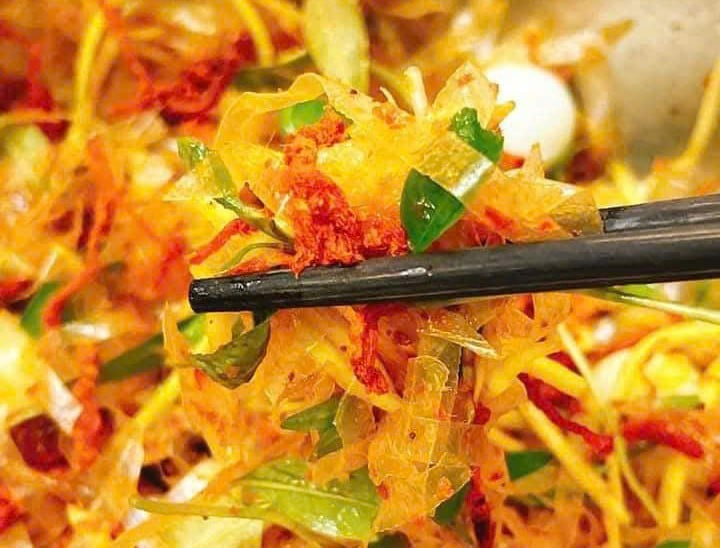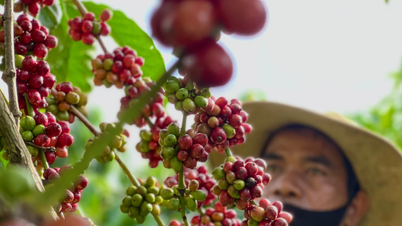
Few people know that Tay Ninh mixed rice paper was created by the people of Trang Bang from a moment of improvisation, and then became a popular dish that is famous far and wide. Tay Ninh land is blessed with sunny days and foggy nights. Therefore, people have taken advantage of this gift to make the famous regional specialty rice paper.
Not only is it a national snack sought after everywhere, mixed rice paper is also the pride of Tay Ninh cuisine , a symbol of creativity and sophistication, and the unique culinary culture of the local people.
Each plate, each bag of mixed rice paper is not simply a combination of familiar ingredients, but a symphony of flavors, blended from traditional secrets, creating an irresistible attraction that you will not be able to find anywhere else.
What makes Tay Ninh mixed rice paper so irresistible is the subtle blend of many ingredients that seem simple but create an unforgettable taste sensation. Each plate, each bag of mixed rice paper is a colorful, multi-flavored picture, stimulating all the senses.
The main indispensable ingredient is Tay Ninh rice paper – a thin, flexible cake made from rice flour, dried in dew to keep its softness and toughness. The rice paper is cut into bite-sized strands, creating the perfect foundation for other ingredients to adhere to and absorb the spices.
Next are the dried foods: beef jerky, squid jerky, chicken jerky, or even pork jerky, shredded or chopped, bringing a rich salty, sweet taste and an interesting chewy texture. Fragrant fried onion fat, crispy roasted peanuts, fatty boiled quail eggs, sour shredded green mango, fragrant Vietnamese coriander... all come together, creating a variety of flavors and colors.
But the soul of the mixed rice paper dish is the mixed sauce. Each restaurant will have its own recipe, but in general, the sauce is usually mixed from kumquat juice, satay, annatto oil, sugar, fish sauce and a little fresh chili.
The sour, spicy, salty, and sweet flavors blend harmoniously, permeating each strand of rice paper and other ingredients, creating a unique, unmistakable flavor. When mixed well, all the ingredients blend together, creating a dish with enough sour, spicy, salty, sweet, fatty, rich, aromatic flavors... that make the eater exclaim endlessly.
Not just a snack, mixed rice paper is also associated with the childhood of many generations, a familiar dish for students after school, an appetizer for gatherings with friends, or simply a dish to relieve boredom in the afternoon. Wherever, whenever, each plate, each bag of fragrant, rich mixed rice paper always has a special appeal.
I have a close friend, every time she comes back from New Zealand to visit Tay Ninh, we have an unchanging appointment: the familiar sidewalk coffee corner in the heart of the small city.
The constant combo is always a glass of iced coffee with a plate of rice paper mixed with shrimp salt. The plate of soft, chewy rice paper is cut into small strands, then sprinkled with a bit of the typical red-orange shrimp salt, and garnished with a few slices of fragrant, golden fried shallots.
Add to that the light sour taste of shredded green mango, a few boiled quail eggs, and finally sprinkle with crispy roasted peanuts. All are mixed well, just pick up each piece and put it in your mouth... all senses seem to melt, blending into the rich flavor of a cup of warm coffee.
My friend kept praising the dish as she ate, it was still deeply in her memory. Just like that, that plate of rice paper witnessed our intimate stories, our hearty laughter, our sincere sharing about our past, present and future.
It is a window into time, taking us back to the carefree days of our youth. Each rice paper strand, each grain of shrimp salt, or a bit of sour mango reminds us of school days, of hanging out at cafes, or of gatherings with friends.
It carries the strong flavor of Tay Ninh, of the sun, the wind, of the most simple and familiar things. Even though you live thousands of miles away from home, that flavor is still an invisible string that keeps her back to her homeland, to the dear things that have made her who she is.
Convenience is also a factor that makes mixed rice paper popular. You can easily find small street carts, popular snack shops or even in specialty restaurants serving mixed rice paper.
With only ten to a few tens of thousands of dong, you can have a full plate of mixed rice paper, enough to satisfy your craving. However, to fully enjoy its human delicacies, you need some leisurely time. Eat slowly, bit by bit, like a person enjoying tea peacefully every morning.
If you don’t mind, you can use your hands instead of chopsticks, picking up each rice paper strand and putting it in your mouth. My little students often say: “Eating with your hands is delicious, fun, and you can feel the rustic nature of our country people”. And the kids eat in a very simple way. That is also one of the ways for you to enjoy this Tay Ninh specialty to the fullest.
Although traditional mixed rice paper is already very attractive, to satisfy the diverse tastes of diners, many variations have been created, bringing new experiences.
Mixed rice paper salad - the most popular version, with a full range of dried foods, mango, peanuts, quail eggs; mixed rice paper with dried chicken - focuses on the delicious flavor of shredded dried chicken, often mixed with sweet and sour tamarind sauce; mixed rice paper with dried beef - stands out with the salty, chewy flavor of dried beef, combined with a little spicy satay; mixed rice paper with salt and lime - simpler but no less attractive, with only rice paper, salt and lime, fried onions and a little cooking oil, creating a characteristic salty and sour flavor; rolled rice paper - not mixed, but another variation of Tay Ninh rice paper, rice paper is rolled with the same ingredients as mixed rice paper, dipped in sweet and sour sauce. There is even vegetarian mixed rice paper, which is just as delicious.
If you have the opportunity to visit Tay Ninh city, do not miss the opportunity to enjoy mixed rice paper at the famous places below to fully experience the authentic flavor:
Tay Ninh Market: This is a “paradise” of rice paper. You can find dozens of stalls selling mixed rice paper with different secret recipes. Each stall has its own characteristics, from the stickiness of the rice paper, the spiciness of the satay to the richness of the dried products.
Snack shops on Cach Mang Thang Tam and Nguyen Trai streets. These are streets with many snack shops, including banh trang tron. These shops often have more spacious spaces, where you can sit and enjoy.
Street vendors. Sometimes, small, simple street vendors contain the most flavorful and authentic mixed rice paper flavor, because that is where the family recipes are preserved for many generations.
The interesting thing is that nowadays, Tay Ninh mixed rice paper is sold on almost every street from North to South, spread across all provinces and cities, almost everywhere.
Mixed rice paper is not only a dish, but also a part of Tay Ninh culinary culture. It shows the ingenuity and creativity of local people in processing simple ingredients into attractive dishes. This dish also reflects the simple, close lifestyle and hospitality of the people here.
When enjoying mixed rice paper, you are not just eating but also experiencing a part of the soul of Tay Ninh land. That sweet, salty, spicy and sour taste seems to encapsulate the quintessence of this land - from the sunshine and wind of the climate, the richness of agricultural products to the enthusiasm of the people.
Tay Ninh mixed rice paper is not only a snack, but has become a cultural feature, a pride of Tay Ninh people. With its unique flavor, the delicate blend of ingredients and convenience, this dish has conquered the hearts of millions of people.
Whether you are a foodie or simply a tourist looking for new experiences, try Tay Ninh mixed rice paper once to fully experience its irresistible appeal. Surely, you will be fascinated and want to come back to enjoy it many more times.
Mai Thao
Source: https://baotayninh.vn/banh-trang-tron-tay-ninh-mon-an-vat-lam-say-long-nguoi-a190436.html






![[Photo] Top players gather at the 2025 Nhan Dan Newspaper National Table Tennis Championship](https://vphoto.vietnam.vn/thumb/1200x675/vietnam/resource/IMAGE/2025/5/23/9ad5f6f4faf146b08335e5c446edb107)



























































































Comment (0)